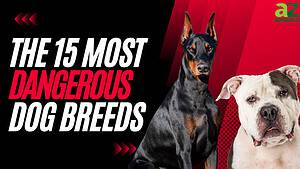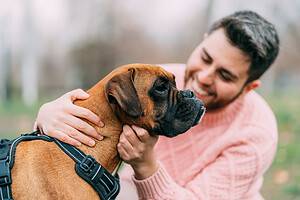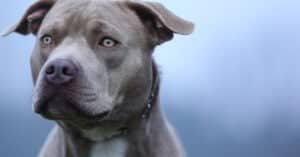Dogs have been domesticated to serve and protect man. One of the most hardworking members of the police force, which serves and protects civilians, is police dogs. They are also called k9 officers, where “k9” is a homophone for “canine.” A k9 unit is a specialized group of law enforcement officers who train and care for their k9 partners while the dogs work to carry out the duties of enforcing the law, apprehending criminals, stopping crimes, and much more. We are familiar with the German Shepherd or Belgian Malinois as being common k9 breeds. But did you know there are different types of police dogs? That’s right, a k9 can be trained for very specific purposes. Let’s explore the different types of police dogs together.
Types of Law Enforcement Dogs
The two main types of law enforcement dogs are police dogs and military dogs. While both serve and protect, police dogs help in crimes and military dogs help in times of war.
There are two main types of police dog work. General-purpose police dog duties have the k9 accompany his law enforcement handler when responding to traffic stops, calls, or emergencies, and helps to apprehend suspects of crimes and accompany in any other dealings with the public.
Specialized k9s additionally have the responsibilities of any specific job where the k9 takes the lead:
- Sniffing for illegal drugs, chemicals or explosives
- Identifying people who handled such substances
- Search and rescue for kidnapped or missing people
- Finding hidden human bodies or body parts
The k9 job duties can therefore be divided into apprehension, detection, search, and rescue, or patrol. Official specializations are Narcotics K9s, Explosives/Gunpower K9s, or Apprehension/Search K9s. Detection dogs can search for narcotics or bombs and explosives, like their military counterparts.
As for military dogs, they can be divided into single-purpose, dual-purpose, and multi-purpose. Single-purpose dogs sniff out explosives, narcotics, or humans. Those that sniff out explosives detect specific explosives (EDDs or Explosive Detector Dogs) on-leash or, in the case of Specialized Search Dogs, are off-leash to detect explosives at long ranges. Mine Detector Dogs (MDDs) are also off-leash and detect unexploded ordnance and buried munitions. There are also Narcotics Detector Dogs, (NDDs) which differ from EDDs by specializing in finding drugs.
Dual-purpose dogs have either of the single tasks, plus scouting abilities. Patrol Explosive Detector Dog (PEDD) and Patrol Narcotics Detector Dog (PNDD) are both used by military police and law enforcement in every service.
Multi-purpose military working dogs, also called multi-purpose k9s or MPCs, are mainly used by Special Operations for parachuting and rappeling. They can wear tactical vests, night vision or infrared camera goggles, and other specialized equipment.
The most common types of military k9s are Sentry Dogs, Scout or Patrol Dogs, Messenger Dogs, Mine Dogs, Tunnel Dogs, Casualty Dogs, and Explosives Detection Dogs. On a wider scale, their work can involve duties and positions such as:
- Mascots, patrols, scouts, and sentries
- Messengers
- Leading assault force against mounted troops or attacking
- Trackers
- Haulers of machine gun and other supplies
- Bomb and explosion detection (EDD)
- Search and rescue or search and report casualties
- Mine (MDD or M-1) or tunnel detection dogs
- Law enforcement, such as the National Guard in times of civil strife
Military k9s sometimes have rankings. When they do, they are given higher rankings than their handlers. This is done because in the military, a k9 is a Non-Commissioned Officer (NCO) or Petty Officer and the higher ranking is meant as a sign of respect.
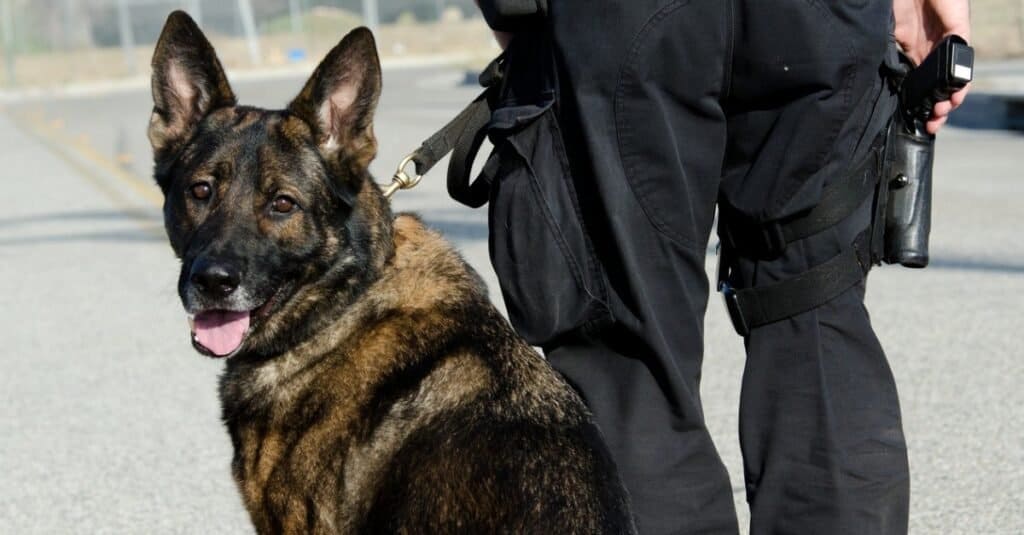
©iStock.com/aijohn784
Law Enforcement Dog Training
Law enforcement dog training is tough, and not all dogs pass. From a young age, the different types of police dogs and military dogs have obedience training. Included is the ability to obey the following commands:
- Sit
- Stand
- Stay
- Down
- Come
- Jump
- Go Ahead
- Go Inside
- Track
- Fetch
- Bite
Obedience training also includes the ability to perform the tasks of patrolling, drug detection, bomb detection, and/or other scent tracking. Believe it or not, the k9 unit’s training doesn’t end when they enter law enforcement. Their training is continuous so that the k9 and the police officer can work in perfect coordination. Their military counterparts, too, have continuous training. Both the dogs and their handlers must be certified every year, which includes daily obedience training and bonding.
Law Enforcement Dog Breeds
Certain dog breeds are favored in k9 work for the police and military depending on the job and the breed’s strong natural abilities, such as German Shepherd or Belgian Malinois. A dual-purpose or multi-purpose law enforcement k9 tends to be a cross of several breeds so as to have more than one specialized skill. Here are the main pure or pedigree breeds divided by groups:
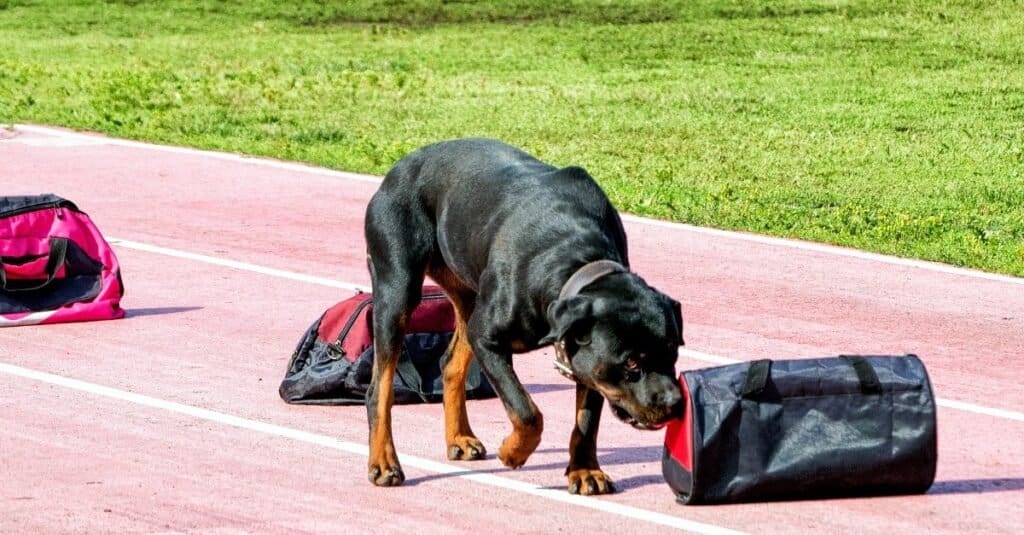
©iStock.com/Sergei Ginak
Sporting Dogs
Sporting dogs are hunting dogs that help hunters in the finding, capturing, and retrieval of game birds. Labrador Retriever, Golden Retriever, German Shorthaired Pointer, Springer Spaniel, and English Cocker Spaniel are the most popular for k9 jobs. They tend to be quieter, gentler breeds used for detection work, such as for explosives, while unobtrusive.
Hound Dogs
Like sporting dogs, hounds are hunting dogs, except they pursue warm-blooded game using sight and scent. Bassett Hound, Bloodhound, Beagle, and Rajapalayam are popular for various types of detection in k9 work.
Working Dogs
Although all k9s are working dogs, the working dog group includes all breeds that were developed for protection and/or physical work. Boxer, Rottweiler, Mastiff, Doberman Pinscher, Akita Inu, Cane Corso, Siberian Husky, and Alaskan Malamute are used in k9 jobs involving security, providing transport, or carrying supplies.
Terrier Dogs
Terriers were developed to pursue underground rodents and other vermin, digging them out and shaking them to death. In military work, they hunt down vermin in the trenches but can also act as messengers or scouts, detect wounded soldiers, carry supplies, or attack while in police work they engage in detection and apprehension. Airedale Terrier, Irish Terrier, American Pitbull Terrier, and Black Russian Terrier are commonly used k9 breeds. The Black Russian Terrier is a new breed that is a cross of 17 different breeds, including Airedale Terrier, Rottweiler, and Giant Schnauzer, and it is used for patrol, mine detection, and search and rescue.
Herding Dogs
Herding dogs are used in k9 work to use their natural herding and protective instincts on humans as well as their intelligence, loyalty, and athleticism. Australian Shepherd, Border Collie, German Shepherd, Groenendael (Belgian Malinois, Belgian Shepherd, or Belgian Tervuren), Dutch Shepherd, Briard, Giant Schnauzer, and Bouvier des Flandres are popular herding breeds for k9 work. The German Shepherd is used for security, apprehension, messengers, and ammo carriers, while the Australian Shepherd chases after criminals and helps in search and rescue. The Border Collie was used as messengers, sentries, and wounded soldier finders, but is no longer used.
Life After Law Enforcement Dog Work
What happens after a k9 is retired or is unable to continue law enforcement work? Having gone through obedience training since puppyhood and working extremely hard, they can retire from old age or negative behaviors resulting from their high-stress jobs. They are typically ready to retire between 7 and 11 years of age. Before Robby’s Law was signed in 2000, they were unfortunately euthanized. These days, however, they are adopted, and they adjust easily to family life. Their handlers are the first choice, followed by other service members, and then the general public.
The different types of police dogs or k9s are working dogs that serve and protect their handlers as well as civilians. Whether their job is to help in law enforcement or perform military duties, their obedience training makes use of their skills and allows for bonding between them and their handlers. They are extremely valuable in stopping crimes and doing work that humans cannot do or cannot do as well as dogs.
Up Next…
Keep reading these posts for more incredible information about key animal facts.
- Types of Working Dogs: They sniff out explosives, guard property, and herd cattle, in addition to so much more. Read about these hardworking dogs and the best breeds for specific roles.
- Best Big Dog Breeds: Some have a mind of their own, others, an elephant-like memory. But the one thing that unites them is their size. Find out just how big they are capable of getting.
- Types of Retriever Dogs: They were bred to catch game, hence their name. Read all about the different breeds of this category of canine which is hardy, yet friendly and intelligent.
The photo featured at the top of this post is © VAKS-Stock Agency/Shutterstock.com
Ready to discover the top 10 cutest dog breeds in the entire world?
How about the fastest dogs, the largest dogs and those that are -- quite frankly -- just the kindest dogs on the planet? Each day, AZ Animals sends out lists just like this to our thousands of email subscribers. And the best part? It's FREE. Join today by entering your email below.
Thank you for reading! Have some feedback for us? Contact the AZ Animals editorial team.



